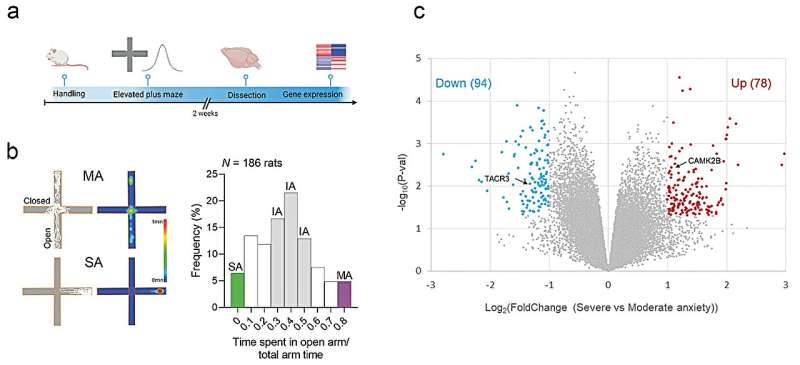This article has been reviewed according to Science X's editorial process and policies. Editors have highlighted the following attributes while ensuring the content's credibility:
fact-checked
peer-reviewed publication
trusted source
proofread
Mechanism linking anxiety to testosterone discovered by scientists

A study has unveiled a significant link between anxiety disorders and a brain receptor known as TACR3, as well as testosterone.
Prof. Shira Knafo, head of the Molecular Cognitive Lab at Ben-Gurion University, led the research published last month in the journal Molecular Psychiatry.
Anxiety is a common response to stress, but for those dealing with anxiety disorders, it can significantly impact daily life. Clinical evidence has hinted at a close connection between low testosterone levels and anxiety, particularly in men with hypogonadism, a condition characterized by reduced sexual function. However, the precise nature of this relationship has remained unclear until now.
Prof. Knafo discovered male rodents exhibiting exceedingly high anxiety levels had notably lower levels of a specific receptor called TACR3 in their hippocampus. The hippocampus is a brain region closely associated with learning and memory processes. TACR3 is part of the tachykinin receptor family and responds to a substance known as neurokinin. This observation piqued the researchers' curiosity and was the foundation for an in-depth investigation into the link between TACR3 deficiency, sex hormones, anxiety, and synaptic plasticity.
The rodents were classified based on their behavior in a standard elevated plus maze test measuring anxiety levels. Subsequently, their hippocampi were isolated and underwent gene expression analysis to identify genes with varying expressions between rodents with extremely low anxiety and those with severe anxiety.
One gene that stood out was TACR3. Previous research had revealed that mutations in genes associated with TACR3 led to a condition known as "congenital hypogonadism," resulting in reduced sex hormone production, including testosterone. Notably, young men with low testosterone often experienced delayed sexual development, accompanied by depression and heightened anxiety. This pairing led researchers to investigate the role of TACR3 further.
Prof. Knafo and her team were aided in their research by two innovative tools they crafted themselves. The first, known as FORTIS, detects changes in receptors critical for neuronal communication within living neurons. By utilizing FORTIS, they demonstrated that inhibiting TACR3 resulted in a sharp increase in these receptors on the cell surface, blocking the parallel process of long-term synaptic strengthening, known as LTP.
The second pioneering tool employed was a novel application of cross-correlation to measure neuronal connectivity within a multi-electrode array system. This tool played a pivotal role in uncovering the profound impact of TACR3 manipulations on synaptic plasticity.
Synaptic plasticity refers to the ability of synapses, the connections between brain cells, to change their strength and efficiency. This dynamic process is fundamental for the brain's adaptation to the environment. Through synaptic plasticity, the brain can reorganize its neural circuitry in response to new experiences. This flexibility allows for the modification of synaptic connections, enabling neurons to strengthen or weaken their communication over time.
Essentially, synaptic plasticity is a key mechanism by which the brain encodes and stores information, adapting continuously to the ever-changing external stimuli and internal states. Importantly, it revealed that deficiencies stemming from TACR3 inactivity could be efficiently rectified through testosterone administration, offering hope for novel approaches to address challenges related to anxiety associated with testosterone deficiency.
TACR3 is seemingly a central player in bridging anxiety and testosterone. The researchers have unraveled the complex mechanisms behind anxiety and opened avenues for novel therapies, including testosterone treatments, that could improve the quality of life for individuals grappling with sexual development disorders and associated anxiety and depression.
More information: Magdalena Natalia Wojtas et al, Interplay between hippocampal TACR3 and systemic testosterone in regulating anxiety-associated synaptic plasticity, Molecular Psychiatry (2023). DOI: 10.1038/s41380-023-02361-z




















